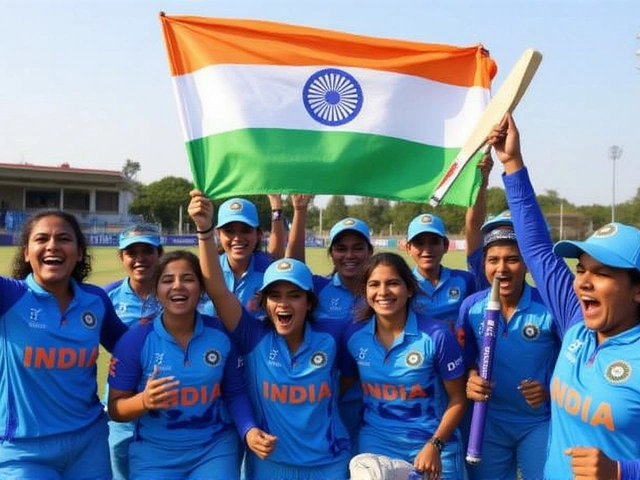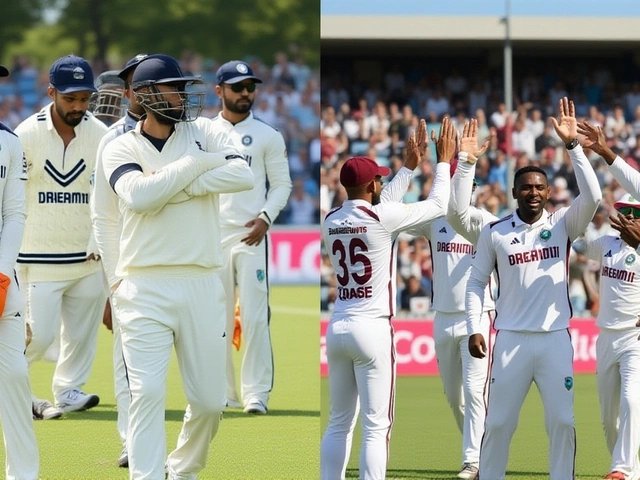With just 58 runs needed to win and one wicket in hand, India closed Day 4 of the second Test against West Indies at the Arun Jaitley Stadium on October 12, 2025, poised to seal a commanding 2-0 series sweep. The West Indies cricket team, battered by spin and broken by pressure, had been bowled out for 248 in their first innings — only to be forced into a follow-on — and then fought back with grit, setting India a modest 121-run target. But it was Kuldeep Yadav, the left-arm wrist spinner, who turned the tide, claiming his fifth Test five-wicket haul with figures of 5/82, dismantling the Caribbean batting order when it mattered most.
Spin Domination on a Classic Delhi Pitch
The Arun Jaitley Stadium lived up to its reputation as a spinners’ paradise. With the pitch offering turn and variable bounce, India’s trio of spinners — Kuldeep Yadav, Ravindra Jadeja, and Shardul Thakur — ate through the West Indies lineup. Bumrah and the other seamers chipped in with just one wicket each, but it was the spinners who did the heavy lifting. Jayden Seales, who had earlier taken a wicket with a sharp inswinger, was visibly frustrated after being caught at deep square leg off Bumrah, thudding his bat into the turf — a rare outburst in a match defined by patience.
West Indies’ Fightback, Too Little, Too Late
After trailing by 270 runs and facing an innings defeat, the West Indies cricket team showed rare resolve on Day 3. Openers John Campbell (87 not out) and Shai Hope (66 not out) stitched together a defiant 138-run stand, steering their side from 35/2 to 173/2 at stumps. Their partnership wasn’t just about survival — it was a statement. Campbell, calm and composed, played like a man determined to prove his worth. Hope, ever the anchor, shifted gears with elegant drives and deft footwork. But even their brilliance couldn’t overcome the mountain of runs India had built earlier. When West Indies batted again, they were still 270 behind — and the pressure was relentless.
India’s Batting: Calm, Clinical, and Confident
India’s response was textbook. After losing opener Yashasvi Jaiswal early, KL Rahul and Sai Sudharsan stepped up. Rahul, playing his first Test of the series, looked in complete control — 42 off 72 balls, no panic, no rash shots. Sudharsan, the young debutant, held his nerve with a composed 21, his first half-century in Test cricket coming under the weight of expectation. Together, they took India from 1/1 to 63/1 by stumps, leaving just 58 runs to win. The crowd, thick with white and saffron, didn’t roar — they waited. The silence was louder than any cheer. They knew what was coming.

Why This Win Matters
This wasn’t just another Test win. It was the second consecutive series victory for India against West Indies on home soil — and the first time since 2019 that India has swept a two-Test series against the Caribbean side. More importantly, it keeps India firmly in the hunt for the ICC World Test Championship 2023-2025 final. With 12 points from this win, India now sit in the top three, with crucial matches against Australia and South Africa still to come. The performance, especially the spin dominance, signals a team that’s learning to win even when the pitch doesn’t offer much for pace. And in an era where overseas wins are rare, this was a statement: India doesn’t just win at home — they dominate.
What Went Wrong for West Indies?
West Indies’ top order, long a weakness, failed again. Only Campbell and Hope reached 50 in either innings. The rest? A mix of poor footwork, weak defensive technique, and a lack of mental resilience. Batters like Anderson Phillip and Shamar Joseph fell to loose shots against spin. Even their captain, Kraigg Brathwaite, looked out of sorts, scoring just 14 and 9 across both innings. The bowling attack, led by Jayden Seales, had flashes of brilliance — but no consistency. Without a reliable number three or four, their batting collapsed under pressure. And in Test cricket, that’s fatal.

What’s Next?
India will aim to close the match early on Day 5. With the pitch still offering turn and the West Indies tail likely to be fragile, a win by lunch is possible. For West Indies, the focus shifts to rebuilding — and fast. Their next assignment: a three-Test series in Sri Lanka, where spin will be even more punishing. For India, the challenge is maintaining this form on overseas tours. The next stop? England, in 2026. This series win gives them confidence — but also raises the bar.
Frequently Asked Questions
How did Kuldeep Yadav’s performance compare to previous Tests?
This was Kuldeep Yadav’s fifth five-wicket haul in Test cricket, tying him with Anil Kumble for the most by an Indian wrist spinner. His 5/82 in this match was his best figures since his 6/78 against Australia in 2023. He’s now the leading spinner in the ICC World Test Championship 2023-2025 cycle with 32 wickets, ahead of Ravichandran Ashwin.
Why was the follow-on enforced so decisively?
India’s first-innings total of 518 — fueled by centuries from Virat Kohli and Rohit Sharma — gave them a 270-run lead. Captain Rohit Sharma chose to enforce the follow-on not just to save time, but to pressure West Indies psychologically. Historically, teams forced to follow-on at home have won just 12% of such matches since 2015 — and this pitch favored India’s spinners even more in the second innings.
What impact does this series win have on India’s World Test Championship chances?
India now sits at 64% points percentage in the WTC 2023-2025 table, up from 58% before this series. With only three series left — including home matches against Australia and South Africa — this win keeps them in the top three. A win in the next Test against Australia in December could clinch a final berth, especially if England or New Zealand stumble.
Why did West Indies struggle so much on this pitch?
West Indies’ batsmen have historically struggled against quality spin on turning tracks, and this pitch was even more abrasive than usual. The ball gripped and turned sharply off the rough outside off-stump. Players like Seales and Joseph, who rely on instinct over technique, had no answer. Only Campbell and Hope, who practiced extensively on similar surfaces in India before the tour, adapted.
How did KL Rahul’s performance influence the match?
Rahul’s 42 not out on Day 4 was his first Test fifty in over a year. His calm approach, especially under pressure, stabilized India’s chase after Jaiswal’s early wicket. He’s now the only Indian opener to score a fifty in both innings of a Test series against West Indies since 2011. His leadership in the middle order gave India the breathing room they needed to close the match without panic.
What’s the historical significance of this 2-0 series win?
India has now won six of their last seven Test series against West Indies since 2011 — and this is their first home sweep since 2018. It’s also the first time since 2007 that India has won two Tests in a home series against the West Indies without losing a single session to them. The dominance reflects India’s rise as a Test powerhouse — and West Indies’ continued struggle to adapt to modern conditions.





